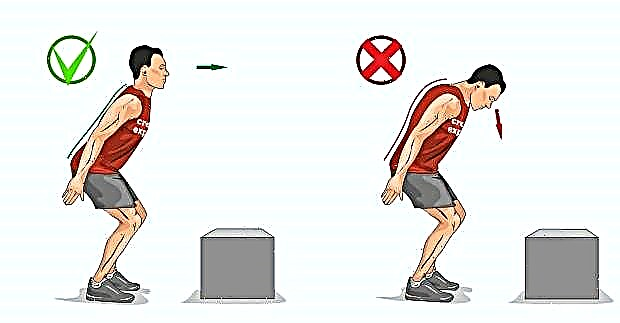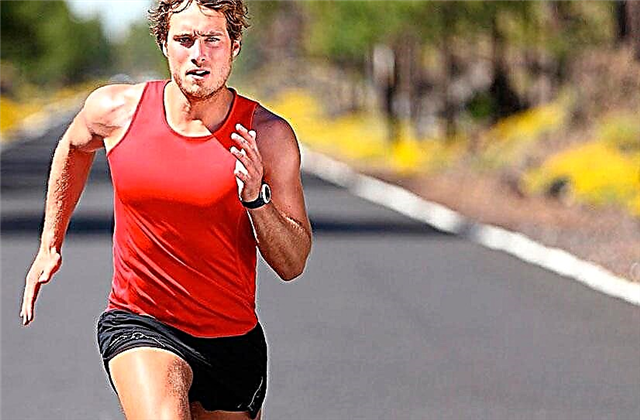Box jumping is one of those distinctive exercises that, after seeing which, you can say: this is definitely from CrossFit! Along with burpees, box jumps have become one of the basic gymnastic exercises in this technique.
Today we will tell you what this beast is:
- Why are they needed - what are they developing?
- How to jump on the box correctly?
- And let's analyze the typical mistakes of beginners.
What does pedestal jumping develop?
Crossfit box jumping primarily works to develop explosive leg strength. The exercise increases the endurance of the whole body, improves its coordination and somewhat flexibility, and is also an excellent addition to weightlifting leg exercises (for example, the classic deadlift with a barbell). Together they "burn" the leg muscles just fine - you come out crawl out of the hall tired and happy. In addition, box jumping trains muscles to contract as quickly as possible in a short period of time, developing jumping ability and speed.
What muscles work
During box jumps, almost all the muscles of the body are turned on. The most intensively involved in the work:
- Calf muscles.
- Hip biceps.
- Buttocks.
- Quads.

The muscles of the shoulder girdle, back, abdominal muscles also participate in the work, and the elasticity of the tendons improves.
Explosive exercises are also good for strengthening the central nervous system. By incorporating them into your training program, you will notice an improvement in overall training productivity. For example, you can work longer and more with different weights, which will help you build mass later.
Execution technique
Box jumps are less traumatic compared to other types of jumps, because less stress on the joints. Therefore, they can be used in training quite often. But! There is a risk of injury by catching a toe on the box, so you need to do this exercise with the utmost collected and attentive. Despite the seeming simplicity, performing pedestal jumps will require extreme concentration from you. The exercise is recommended at the beginning of the workout. Remember that aimless movement is a direct path to injury. Therefore, first carefully understand the technique.
Jumps are performed using one single device - the pedestal. Its size is most often 50, 60 and 75 cm. The height of the box should be chosen based on your level of training. It is worth starting from a low height.
Initial position
The legs are hip-width apart, the back is straight, the chest is forward. The gaze is directed not at the curbstone, but slightly upward. Keep your abdominal muscles tense to avoid rounding your back. In order for the trajectory of the jump to be smooth and the pressure on the joints to be minimal, you should not get too close to the platform.

© leszekglasner - stock.adobe.com
Do not hunch over like a hook - instinctively I want to bend down a little to hang over the box. This is not necessary!
Box jump
- We bend the knee joint, take our hands back. The knees should remain neutral. No need to bend them inward or spread them outward. This will disrupt the technique and may result in injury.
- With a powerful movement of the legs, we push off the floor and make a jump. At the same time, we perform a swing with our arms and slightly pulling our knees to the chest.
- The landing should be soft. In this case, the weight is distributed evenly over the foot. The depth of the squat at the moment of landing on the box is the same as at the start.
- On the pedestal, we do full straightening of the knee and hip joints. The hands also relax.

© leszekglasner - stock.adobe.com
Back from the box
We jump from the curbstone. We land gently on slightly bent legs. From this position, without pause, we again jump. When jumping from the box back, you do not need to make any additional efforts - we just jump down completely relaxed with the most straight back and slightly bent legs.
Attention! There is a kind of crossfit box jumping that is done without stopping. That is, jumping off the box, and being already on the floor, you cannot rest for more than a second and must instantly jump back onto the box. In this case, the jump is done according to the same rules - only with the amendment that a micro-pause can only be made while at the top of the box.
It is worth noting that the amount of energy generated will depend on the length of the shock absorption phase during landing. This phase represents the transition from stretching to contracting the muscles at the beginning of their concentric work. The shorter this phase, the better you will get. In other words, if you jump without delay, you conserve energy and achieve greater motion sharpness.
If you are a beginner and you are unable to re-jump onto the bollard without stopping on the floor, you can try not to jump off the bollard, but simply get off it. However, in this case, the energy of elastic deformation is lost, which reduces the effectiveness of the exercise. Jumping off puts additional stress on joints, tendons, ligaments, and also allows you to do more work in less time.
We watch the technique of performing pedestal jumps in CrossFit in the video - very simple and clear:
Exercise complication
If you have already worked out the jumping technique enough, then you can complicate the exercise by increasing the height of the bollard. To do this, you can simply place a few pancakes on the drawer. To jump to high heights, you will need to learn to pull your legs closer to your chest. When performing this type of jump, you will land on the pancakes while squatting.
Tips for Beginners
Jump rope for about two weeks before doing box jumping. Then practice the correct technique on a small box.
- Note the importance of fully extending your hip joint and landing properly.
- When the height of the box is increased, the technician should not suffer. Do not jump onto the bollard if you are not well trained.
- If you feel pain, excessive tension in the joints, stop doing the exercise.
Typical mistakes
Now let's take a look at the typical mistakes when doing box jumps for CrossFit athletes:
- Wrong position of the spine. Often occurs if the gaze is directed not forward in front of you, but down to the curbstone. At the same time, the back is rounded, which leads to disrupted technique and possible injuries.

- Irrational use of hands when jumping. Hands need to make a strong and clear swing. This will allow you to increase your jump power by up to 40%.
- Improper landing and knee positioning can lead to injuries to the ankle and knee joint. You should land softly on slightly bent legs and from this position immediately jump in one motion.
- A pause after landing on the floor is simply wasting your energy nowhere. It follows that the rest between jumps must be done on a pedestal.
Jumping Progression Program
As stated earlier, the exercise should be done at the beginning of your workout after a good warm-up or paired with a good weight-lifting leg exercise.
| 1 Week | Simple jumping rope for 7-10 minutes |
| 2 week | 2 sets of 5 reps |
| 3 week | 3 sets of 4 reps |
| 4 week | 4 sets of 4 reps |
| 5 week | Raise the height of the box and 3 sets of 5 reps |
| 6 week | 4 sets of 4 reps |
| 7 week | 4 sets of 3 reps |
| 8 week | Raise the height of the box and 3 sets of 5 reps |
Box jumping will fit perfectly into your training program. They work well with other CrossFit exercises like burpees. Also remember to pay attention to stretching. By stretching and warming up your muscles, you prevent injury and generate the energy you need to jump.
If you liked the lesson - share it with your friends on social networks, and also ask questions and share your opinion in the comments!










